Xerox Alto: the world's first PC with Ethernet and a laser printer
It is also one of the first object-oriented
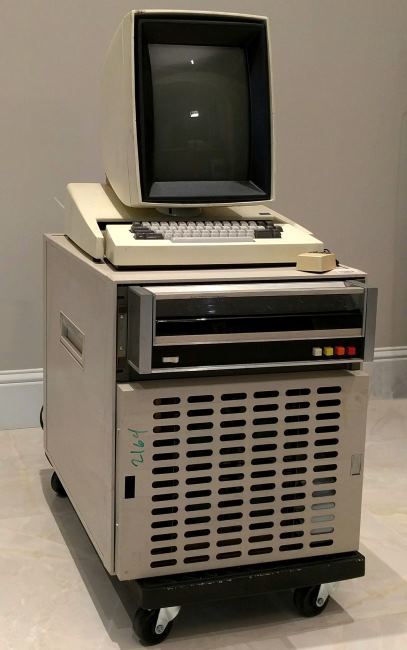
Xerox Alto systems with an Orbit laser printer.
The Xerox Alto personal computer is the first in many ways. This is the first PC with a graphical interface and desktop. Even a novice could work with such a computer. In addition, this is the first computer with integrated Ethernet and its own laser printer. The system also supports the Mesa and Smalltalk programming languages. Alto can be called a revolutionary system for its time - this PC entered the market in 1973. Developed a system of several people: Thacker , Kay , Butler , Taylor .
Xerox has created about 2,000 of these systems for internal use. New computers worked in research laboratories and universities. At the same time, Alto was never sold as a commercial product. Many of the ideas implemented in Alto were used in Xerox Star , a commercial PC model from Xerox. This computer was very expensive, so not all could buy it. However, Star has become relatively successful. Alto and Star made a strong impression on Steve Jobs. The future head of the largest international corporation, having seen the graphical interface of the machines, decided to create something similar. A little later, he realized his plans in the form of Lisa and Macintosh systems, bringing the computers with graphical interface to the mass market.
Xerox Alto was equipped with a 16-bit processor, a vertical raster screen with a resolution of 606 * 808 pixels, two types of keyboards (regular and one-off), and a three-button mouse. The raster display is divided into a number of elements, each of which is associated with a certain part of the computer's memory. The memory stores information about the color, brightness level, and similar characteristics of each area of the screen. Updating the image on the screen of this type is carried out using a processor. For the needs of the Alto raster display, about half of the entire memory of this PC was occupied.
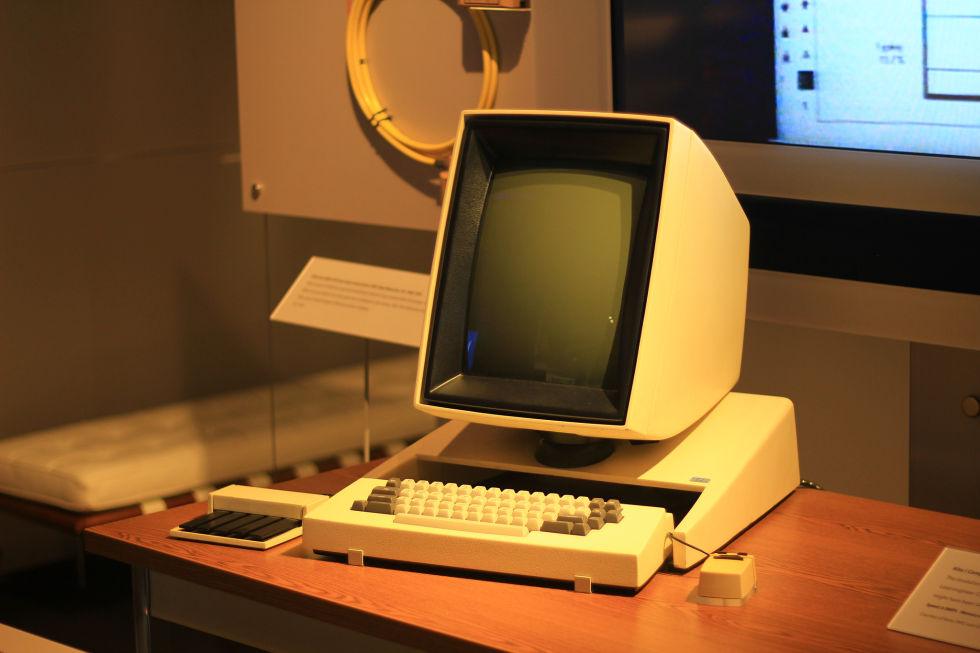
Separately, it is worthwhile to dwell on a mouse - a manipulator of this type was made a key element for entering information during the development of Alto. All elements of the PC software interface are “sharpened” for mouse operation.
The removable disk capacity of the computer was 2.5 MB. This is not much, but files could be accessed over Ethernet from file servers.
In the lower part of the PC case, the developers have placed the boards and the power supply.
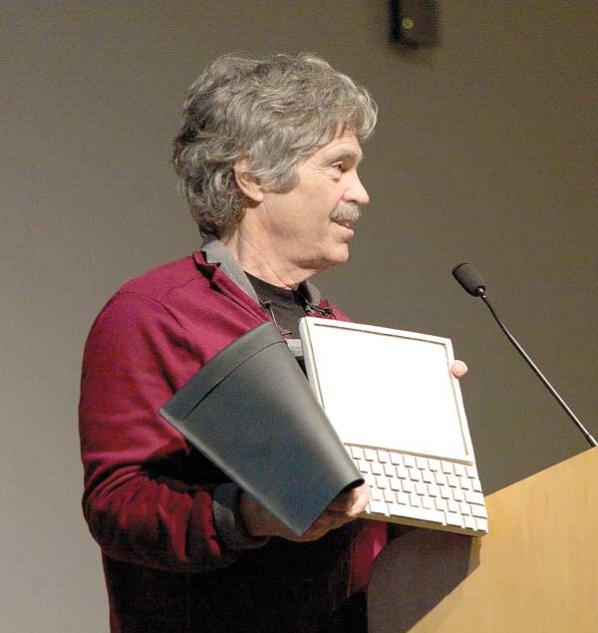
The Xerox Alto developers were inspired by the ideas of Dynabook , developed by Alan Kay . Kay wanted to create a device for training, and developed the concept of such a device in 1968. The concept represented what is now called a laptop (tablet PC also fits into the idea). The target audience of such a system were children, although adults also could work with Dynabook, as Kay believed. The structure and principles of functioning of Dynabook were based on teaching theories proposed by Jerome Bruner and Seymour Papert.
At that time, it was impossible to technically implement the idea of Alan Kay, although Xerox Alto was considered as the first prototype of Dynabook. Alan Kay himself still believesNobody has yet created an analogue of Dynabook, since there are neither key software, nor built-in educational training courses. It is worth mentioning that an important part of the concept is a touchscreen display - here the idea was proposed by Kay long before practical implementation.
Other elements of the concept were also the energy autonomy of the system, its portability and the availability of a network interface. The latter was supposed to be interactive. An object-oriented programming language was to become part of the software system. It was planned to use voice input. Books, by design, could be obtained from the network (paid download).
As mentioned above, many ideas suggested for Dynabook were used in Xerox Alto. New computer developers have proposed to use for distributed computing, office work, graphics processing and personal use.
Alto had a lot of apps. Among others, Bravo word processor, Laurel and Hardy message managers, Markup document illustrator, Draw vector editor, Neptune file manager, Mesa programming languages (Pascal's version), Smalltalk, Lisp are notable. There was a vector graphics editor for integrated circuits and circuit boards, Sil. Officetalk is an experimental forms-processing system.
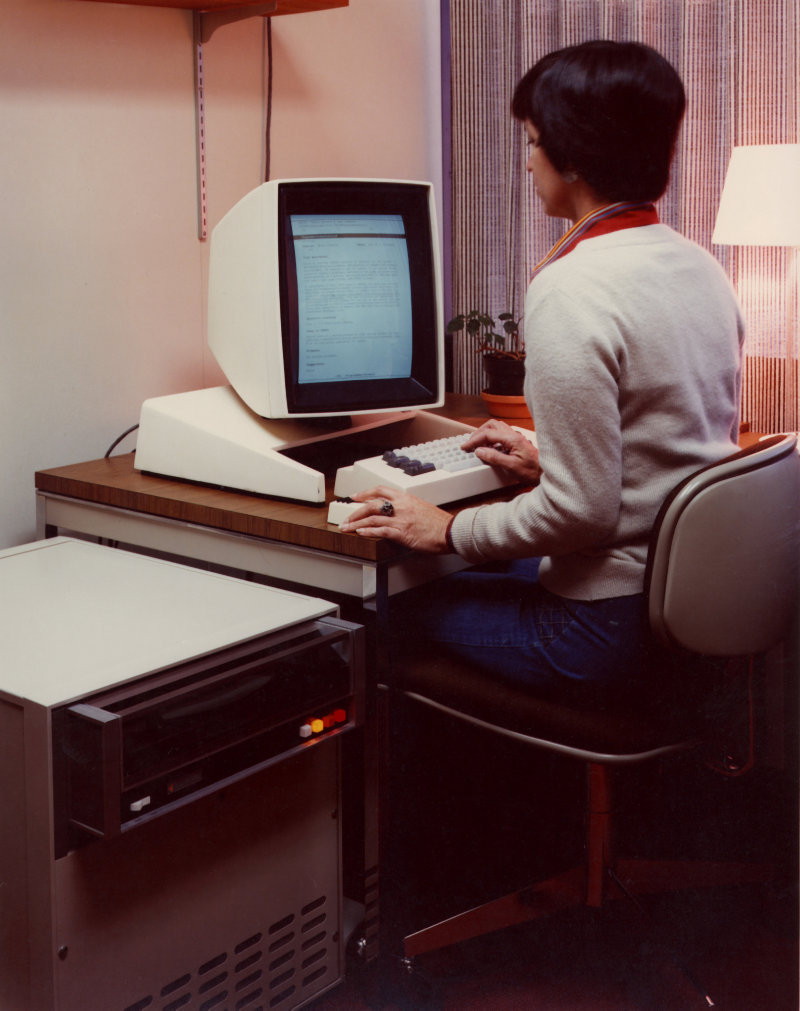
Applications were advanced for their time . For example, the screen of the vector editor Draw was divided into several parts. This menu of brushes, commands, fonts, the image itself, the title and message box. Actually, these are the component parts of almost all modern graphic editors.
Bravo text editor interface was implemented in WYSIWYG. The text on the screen is completely consistent with what the user sees when printing this information.
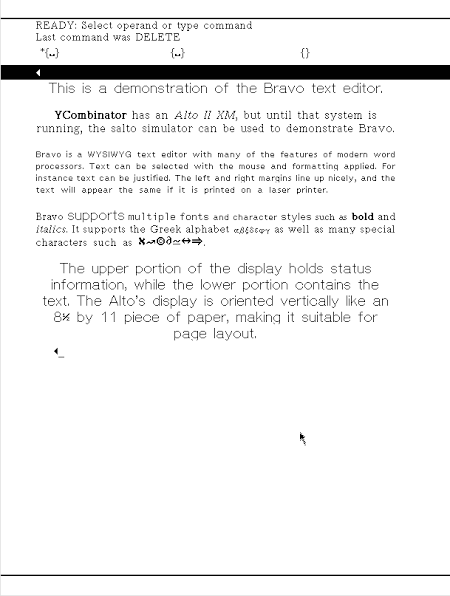
Interface examples for Bravo and Draw
editors The Officetalk form editor was later incorporated into the STAR System office system.
The program shell of the system included an emulator of a standard set of commands, executed with the lowest priority. Other tasks included low-level disk, network, memory, screen, plus sweep and cursor drivers.
The OS was written in Basic Combined Programming Language (BCPL). It is a programming language developed by Martin Richards in 1966, at the University of Cambridge. It was originally intended to write compilers for other languages. By the way, the first program “Hello world” is written in this language.
Part of the OS was the debugger SWAT, which allowed to save the state of the system to a file for later debugging.
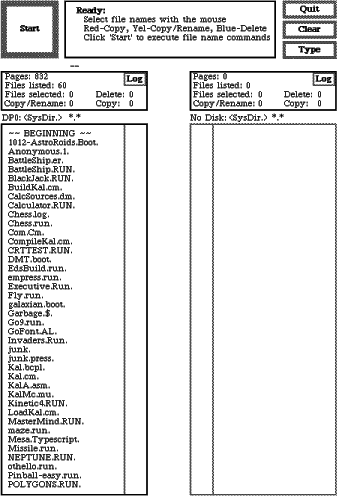
There were games, and one of them was multiplayer. This game was called Alo Trek. It was necessary to control the spacecraft of one of three races: earthlings, Klingons or Romulans.
Another game is Maze:
There were other games:
The network capabilities of the system were also advanced and included FTP with Telnet. Over Ethernet, data could be transmitted at a speed of 2.94 Mbps. Network printing was supported.
The Xerox Alto software simulator is on Github .
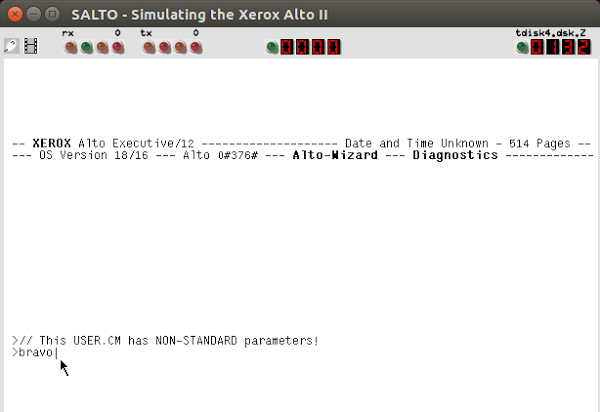
Let me remind you that this system was introduced in 1973. At that time, a 4-bit microprocessor 4004, released by Intel in 1971, was considered a powerful processor. This chip is considered the world's first commercially available single-chip microprocessor. Before the release of the 6502 and Z-80 processors, there were still two years to go, the Apple II persona will be released only after 4 years, in 1977. The Xerox Alto processor was served by hundreds of relatively simple but fast TTL chips. Here they preferred such a structure instead of using slow and not very reliable MOS-chips.
Part of the Alto hardware is 13 circuit boards filled with chips. The size of each board is 7-5 / 16 "at 10", each has about 100 chips. Most of them are bipolar TTL chips of the 7400 series popular at that time. (Exception - MOS-memory chips).
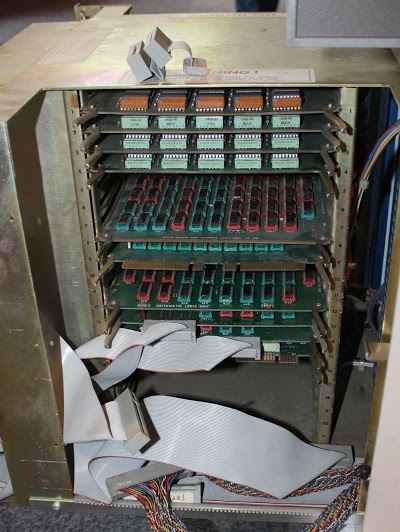
The Xerox Alto processor consists of three cards. The main one was a control board with microcode support (work with 16 parallel tasks with fixed priorities was supported). The second board was an arithmetic logic unit (ALU).

Alto ALU board
This is a processor unit used to perform arithmetic and logical transformations on data. The third board served as the RAM with additional microcode storage and additional processors registers.

RAM board with 80 chips of type 4116, each with a capacity of 16 KB. The total amount of RAM in Alto is 128 KB, but it was possible to install additional fees by expanding the amount of RAM up to 512 KB. Such a memory was called Alto II XM (eXtended Memory).
The frequency of such a processor was 5.8 MHz. Just a few years later, all these three boards will be replaced with just one chip.
As mentioned above, there were two keyboards - regular and chord.

Mice were three-button. Initially, a mechanical mouse was supplied with two perpendicularly arranged mechanical wheels. A little later, it was replaced with a ball mouse.
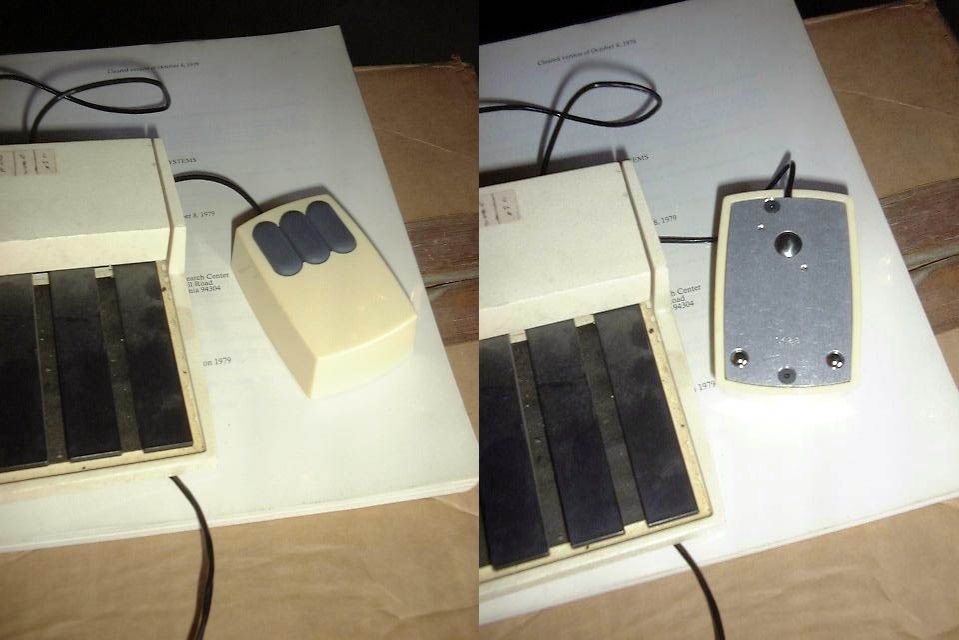
Even optical mice were used: a model with white light and infrared radiation. Buttons, as we see, are located above each other.
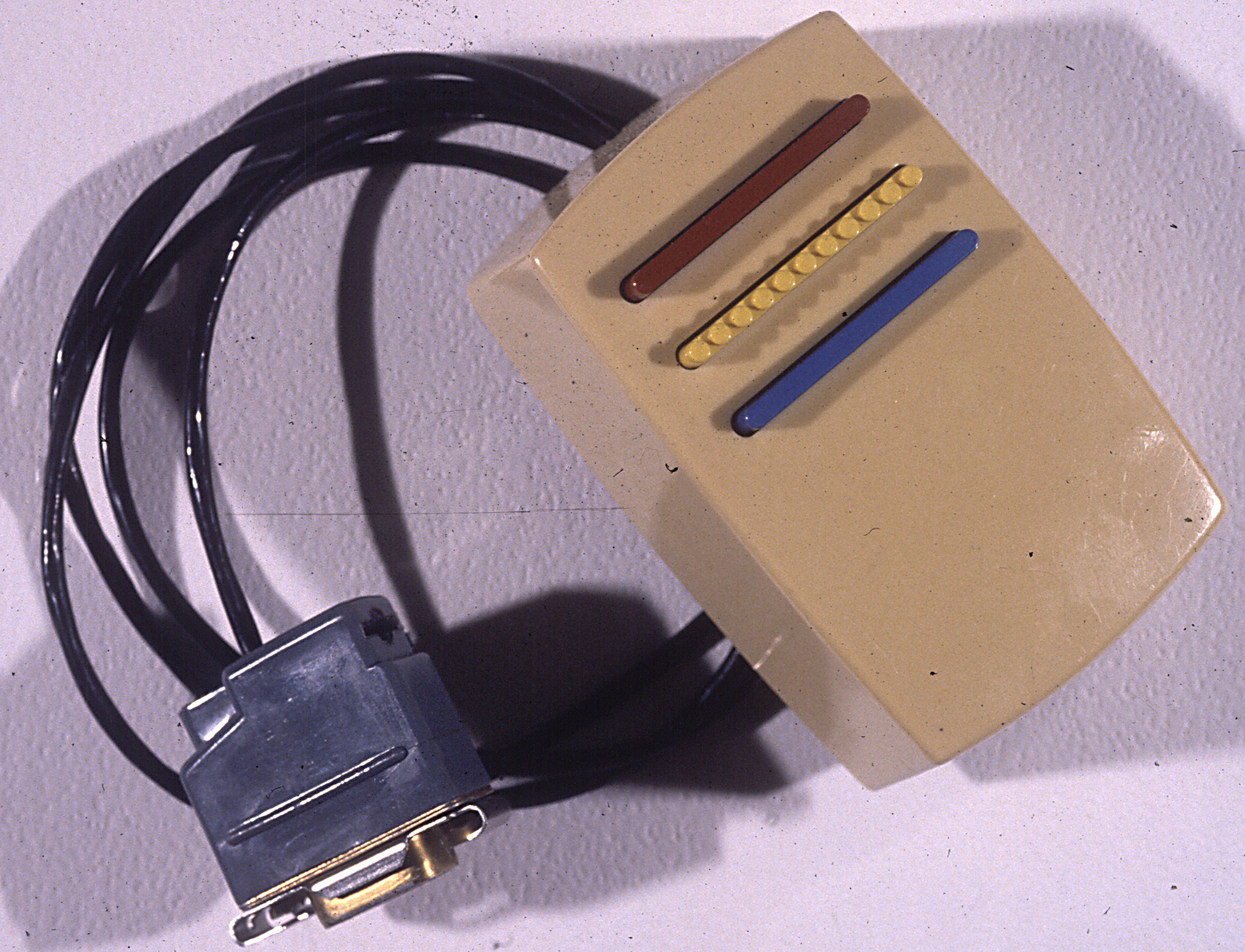
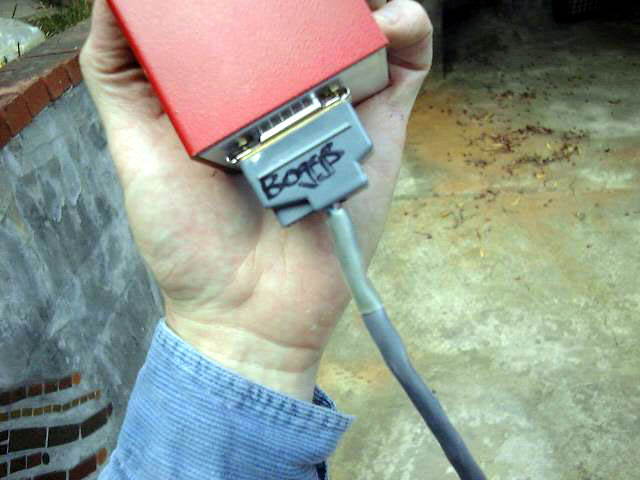
Xerox Alto worked with a network laser printer, model “Orbit” with slots for four control boards. The printer itself could print 16 lines of pixels at a time.
One of the surviving copies of Xerox Alto came to the disposal of Y Combinator. Here it is being restored by a team of professionals. You can follow the progress of the recovery on Twitter .

Xerox Alto systems with an Orbit laser printer.
The Xerox Alto personal computer is the first in many ways. This is the first PC with a graphical interface and desktop. Even a novice could work with such a computer. In addition, this is the first computer with integrated Ethernet and its own laser printer. The system also supports the Mesa and Smalltalk programming languages. Alto can be called a revolutionary system for its time - this PC entered the market in 1973. Developed a system of several people: Thacker , Kay , Butler , Taylor .
Xerox has created about 2,000 of these systems for internal use. New computers worked in research laboratories and universities. At the same time, Alto was never sold as a commercial product. Many of the ideas implemented in Alto were used in Xerox Star , a commercial PC model from Xerox. This computer was very expensive, so not all could buy it. However, Star has become relatively successful. Alto and Star made a strong impression on Steve Jobs. The future head of the largest international corporation, having seen the graphical interface of the machines, decided to create something similar. A little later, he realized his plans in the form of Lisa and Macintosh systems, bringing the computers with graphical interface to the mass market.
Xerox Alto was equipped with a 16-bit processor, a vertical raster screen with a resolution of 606 * 808 pixels, two types of keyboards (regular and one-off), and a three-button mouse. The raster display is divided into a number of elements, each of which is associated with a certain part of the computer's memory. The memory stores information about the color, brightness level, and similar characteristics of each area of the screen. Updating the image on the screen of this type is carried out using a processor. For the needs of the Alto raster display, about half of the entire memory of this PC was occupied.

Separately, it is worthwhile to dwell on a mouse - a manipulator of this type was made a key element for entering information during the development of Alto. All elements of the PC software interface are “sharpened” for mouse operation.
The removable disk capacity of the computer was 2.5 MB. This is not much, but files could be accessed over Ethernet from file servers.
In the lower part of the PC case, the developers have placed the boards and the power supply.
Communication Dynabook and Alto

The Xerox Alto developers were inspired by the ideas of Dynabook , developed by Alan Kay . Kay wanted to create a device for training, and developed the concept of such a device in 1968. The concept represented what is now called a laptop (tablet PC also fits into the idea). The target audience of such a system were children, although adults also could work with Dynabook, as Kay believed. The structure and principles of functioning of Dynabook were based on teaching theories proposed by Jerome Bruner and Seymour Papert.
At that time, it was impossible to technically implement the idea of Alan Kay, although Xerox Alto was considered as the first prototype of Dynabook. Alan Kay himself still believesNobody has yet created an analogue of Dynabook, since there are neither key software, nor built-in educational training courses. It is worth mentioning that an important part of the concept is a touchscreen display - here the idea was proposed by Kay long before practical implementation.
Other elements of the concept were also the energy autonomy of the system, its portability and the availability of a network interface. The latter was supposed to be interactive. An object-oriented programming language was to become part of the software system. It was planned to use voice input. Books, by design, could be obtained from the network (paid download).
As mentioned above, many ideas suggested for Dynabook were used in Xerox Alto. New computer developers have proposed to use for distributed computing, office work, graphics processing and personal use.
Software
Alto had a lot of apps. Among others, Bravo word processor, Laurel and Hardy message managers, Markup document illustrator, Draw vector editor, Neptune file manager, Mesa programming languages (Pascal's version), Smalltalk, Lisp are notable. There was a vector graphics editor for integrated circuits and circuit boards, Sil. Officetalk is an experimental forms-processing system.

Applications were advanced for their time . For example, the screen of the vector editor Draw was divided into several parts. This menu of brushes, commands, fonts, the image itself, the title and message box. Actually, these are the component parts of almost all modern graphic editors.
Bravo text editor interface was implemented in WYSIWYG. The text on the screen is completely consistent with what the user sees when printing this information.

Interface examples for Bravo and Draw
editors The Officetalk form editor was later incorporated into the STAR System office system.
Alto os
The program shell of the system included an emulator of a standard set of commands, executed with the lowest priority. Other tasks included low-level disk, network, memory, screen, plus sweep and cursor drivers.
The OS was written in Basic Combined Programming Language (BCPL). It is a programming language developed by Martin Richards in 1966, at the University of Cambridge. It was originally intended to write compilers for other languages. By the way, the first program “Hello world” is written in this language.
Part of the OS was the debugger SWAT, which allowed to save the state of the system to a file for later debugging.

There were games, and one of them was multiplayer. This game was called Alo Trek. It was necessary to control the spacecraft of one of three races: earthlings, Klingons or Romulans.
Another game is Maze:
There were other games:
- Astro-roids
- Chess
- Galaxians
- Mazewar
- Missile Command
- Rinky Dink (Clint Parker's pinball program)
- Space war
The network capabilities of the system were also advanced and included FTP with Telnet. Over Ethernet, data could be transmitted at a speed of 2.94 Mbps. Network printing was supported.
The Xerox Alto software simulator is on Github .

Hardware
Let me remind you that this system was introduced in 1973. At that time, a 4-bit microprocessor 4004, released by Intel in 1971, was considered a powerful processor. This chip is considered the world's first commercially available single-chip microprocessor. Before the release of the 6502 and Z-80 processors, there were still two years to go, the Apple II persona will be released only after 4 years, in 1977. The Xerox Alto processor was served by hundreds of relatively simple but fast TTL chips. Here they preferred such a structure instead of using slow and not very reliable MOS-chips.
Part of the Alto hardware is 13 circuit boards filled with chips. The size of each board is 7-5 / 16 "at 10", each has about 100 chips. Most of them are bipolar TTL chips of the 7400 series popular at that time. (Exception - MOS-memory chips).

The Xerox Alto processor consists of three cards. The main one was a control board with microcode support (work with 16 parallel tasks with fixed priorities was supported). The second board was an arithmetic logic unit (ALU).

Alto ALU board
This is a processor unit used to perform arithmetic and logical transformations on data. The third board served as the RAM with additional microcode storage and additional processors registers.

RAM board with 80 chips of type 4116, each with a capacity of 16 KB. The total amount of RAM in Alto is 128 KB, but it was possible to install additional fees by expanding the amount of RAM up to 512 KB. Such a memory was called Alto II XM (eXtended Memory).
The frequency of such a processor was 5.8 MHz. Just a few years later, all these three boards will be replaced with just one chip.
Keyboard and mouse
As mentioned above, there were two keyboards - regular and chord.

Mice were three-button. Initially, a mechanical mouse was supplied with two perpendicularly arranged mechanical wheels. A little later, it was replaced with a ball mouse.

Even optical mice were used: a model with white light and infrared radiation. Buttons, as we see, are located above each other.

Ethernet network card

Laser printer
Xerox Alto worked with a network laser printer, model “Orbit” with slots for four control boards. The printer itself could print 16 lines of pixels at a time.
One of the surviving copies of Xerox Alto came to the disposal of Y Combinator. Here it is being restored by a team of professionals. You can follow the progress of the recovery on Twitter .
